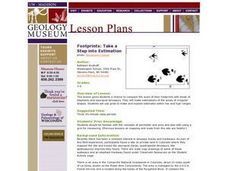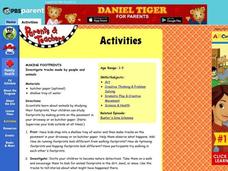Curated OER
Footprints: Take a Step into Estimation
Compare sizes of student footprints with those of elephants and sauropod dinosaurs! Upper graders make estimations of the areas of irregular shapes; students use grids to make and explain estimates within low and high ranges.
Curated OER
Making Footprints
An interesting way of looking at footprints and tracks. Pupils step into a tray of water, and make footprints of various kinds on butcher paper. They tip toe, run, hop, and walk. Then, they take a close look at the differences between...
Curated OER
Track Traces
Students explore animal characteristics by participating in an animal anatomy activity. In this animal tracks lesson, students identify the differences between specific animals and the shape of their footprints. Students utilize a...
Curated OER
Understanding Biodiversity Via Ecological Footprints
Sixth graders investigate the ways in which human beings impact the environment and ecology through the calculation of their own ecological footprint, discussion questions pertaining to biodiversity and potential imbalance hazards, and...
Curated OER
Fascinating Footprints
In this footprints worksheet, students compare dinosaur prints and human prints. Students compare and draw different prints by answering 7 questions.
Curated OER
Fancy Footwork
In this painting worksheet, students remove their shoes and put their feet in a tray of paint. Students paint an abstract painting with their feet. This worksheet is geared to the adults who will be guiding students.
Curated OER
Whose Footprints Are They?
In this matching worksheet, students are given illustrations of 5 different types of footprints and 5 different animals. They are asked to draw a line from each footprint to its corresponding animal.








